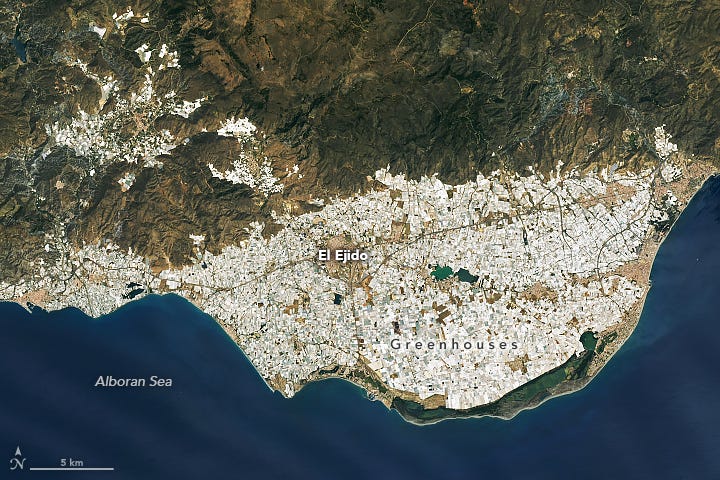Tangerines
Greenhouses bring tangerines to our tables year-round, but at what cost? From exploited workers to dwindling water reserves, the true price of endless abundance demands our attention.
Whenever I have lunch with my grandmother, she always eats a tangerine and tells me how there was a time when tangerines were only available at Christmas, but now you can find them year-round thanks to greenhouses. At 94, she knows first hand how much the world has changed, and savours her tangerine with delight, peeling it slowly and a little clumsily. From her I learnt that it is now, when it is darkest in the Northern Hemisphere, that lemons, tangerines, and oranges are in season. Yet, today, I squeeze lemon juice into my meals all year long.
In Spain, most of our fruits and vegetables are cultivated in greenhouses, just as my grandmother described. Despite 74% of Spain's land being classified as arid, semi-arid, or dry sub-humid1, we’re known as the “orchard of Europe.” Greenhouses, made from plastic sheeting stretched over a frame, trap heat and retain moisture, allowing crops to be harvested earlier and more frequently, sometimes boosting agricultural harvests by six to seven times2. When it comes to maximising the production of fruits and vegetables as efficiently, consistently, and affordably as possible, greenhouses do a fantastic job. However, the question we must ask ourselves is: what is the price we pay for tangerines being in season all year long?

Almería, a town in southern Spain with 320 km² of greenhouse farms, offers a glimpse into what a greenhouse-driven food system looks like. Together, these farms make up the largest greenhouse area in the world, contributing around 38% of Spain’s horticultural output3. Since the 1960s, greenhouse agriculture has reshaped the region, turning it from a poverty-stricken area into one of economic stability. In just one year, from October 2021 to 2022, Almería’s greenhouses produced over 3.5 million tons of fruits and vegetables, valued at 2.79 billion euros4. However, this economic success comes at a cost: migrant workers endure gruelling conditions, often working up to 10-hour shifts in greenhouse temperatures soaring as high as 45–50ºC during summer5.
In January 2020, then UN Special Rapporteur on extreme poverty and human rights, Philip Alston, described the living conditions of migrant workers in Almería shanty towns: ‘I visited areas I suspect many Spaniards would not recognize as a part of their country […] a shantytown with far worse conditions than a refugee camp, without running water, electricity, or sanitation.’
Historically, Almería’s farmland produced the Mediterranean triad—olives, grapes, and wheat—crops that require minimal water and are resilient to droughts. However, as European demand for fruits and vegetables shifted and agricultural practices intensified, the crops changed too. Today, the region's greenhouses specialise in water-intensive, non-native crops like tomatoes and watermelons6. Almería’s agricultural success is supported by a groundwater aquifer, with 80% of its water allocated to farming. Yet, low rainfall and overuse of water resources prevent the aquifers from naturally replenishing. While there are bans on drilling of new water wells, they continue being drilled to depths of up to 2,000 meters. According to Ecologistas en Acción, the aquifers are overexploited, contaminated by microplastics, and increasingly vulnerable to salinisation, as seawater seeps into the groundwater when levels are reduced7.
Greenhouses have transformed what fruits and vegetables in Europe are available when, allowing my grandmother to enjoy tangerines year-round after lunch, and me to use lemons all year long. They've made produce incredibly affordable, yet this price does not reflect the true cost it imposes on the land, water, or workers. They've also disconnected us from the natural rhythms of the seasons.
My mother comes from Southern Italy, and in her family home, there is a small citrus grove. Whenever we travel there for Christmas, my father collects the oranges and makes freshly squeezed orange juice in the morning. My mother uses some of her (well deserved) time off to make bitter orange jam, which she packs in her suitcase to bring back home. The rest of us have to eat as many tangerines as possible, gifting them to cousins, aunts and uncles to make sure nothing is wasted. Being able to experience seasonality and the land is my enormous privilege, one afforded to me through land ownership, yet it is one that only few can experience. It is one that is unroots from in my daily, urban experience of buying groceries.
This essay is not a tirade against greenhouses (and especially not one against citrus). They are only a small piece of the puzzle, but one that prompts the question: how do we want to grow our food? To what extent do we accept the mistreatment of workers and the exploitation of resources as a price worth paying for food? Who deserves access to seasonal, flavourful food?
Thank you to my grandma for being the incipit to explore these big questions




